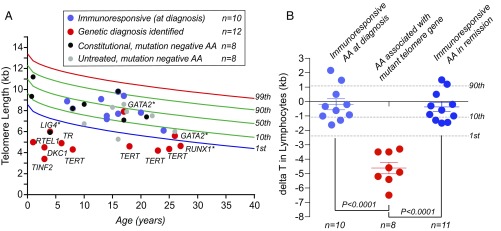Fig. 4.
Utility of TL in the diagnosis of idiopathic bone marrow failure. (A) Lymphocyte TL in 38 prospectively recruited patients with idiopathic aplastic anemia (AA) relative to controls. The red circles denote patients for whom a genetic diagnosis was identified with documentation of a mutation in a telomere maintenance gene (TERT n = 4, TR n = 1, RTEL1 n = 1, DKC1 n = 1, TINF2 n = 1) or nontelomere gene (GATA2 n = 2, RUNX1 n = 1, LIG4 n = 1). The latter group is denoted by an asterisk (*). The blue circles denote patients treated with immunosuppression who responded (all the treated patients responded). The remaining cases, denoted by black and gray circles, denote cases of constitutional aplastic anemia and untreated cases, respectively. Larger circles indicate the 22 patients who reached an informative endpoint (either a genetic diagnosis made or treatment with immunosuppression). (B) The degree of deviation from the age-adjusted median (ΔT) from three groups is shown: prospectively recruited patients who had a response to immunosuppression at 1 y (n = 10, 5 complete response, 5 partial response), patients with telomerase and telomere gene mutations identified in A (TERT, TR, RTEL1, DKC1, TINF2, n = 8), as well as 11 patients successfully treated with immunosuppression who were in remission for 2 y or more. Means ± SEM are shown, Mann–Whitney U test. The 1st, 10th, and 90th percentiles are annotated to the right in B.

